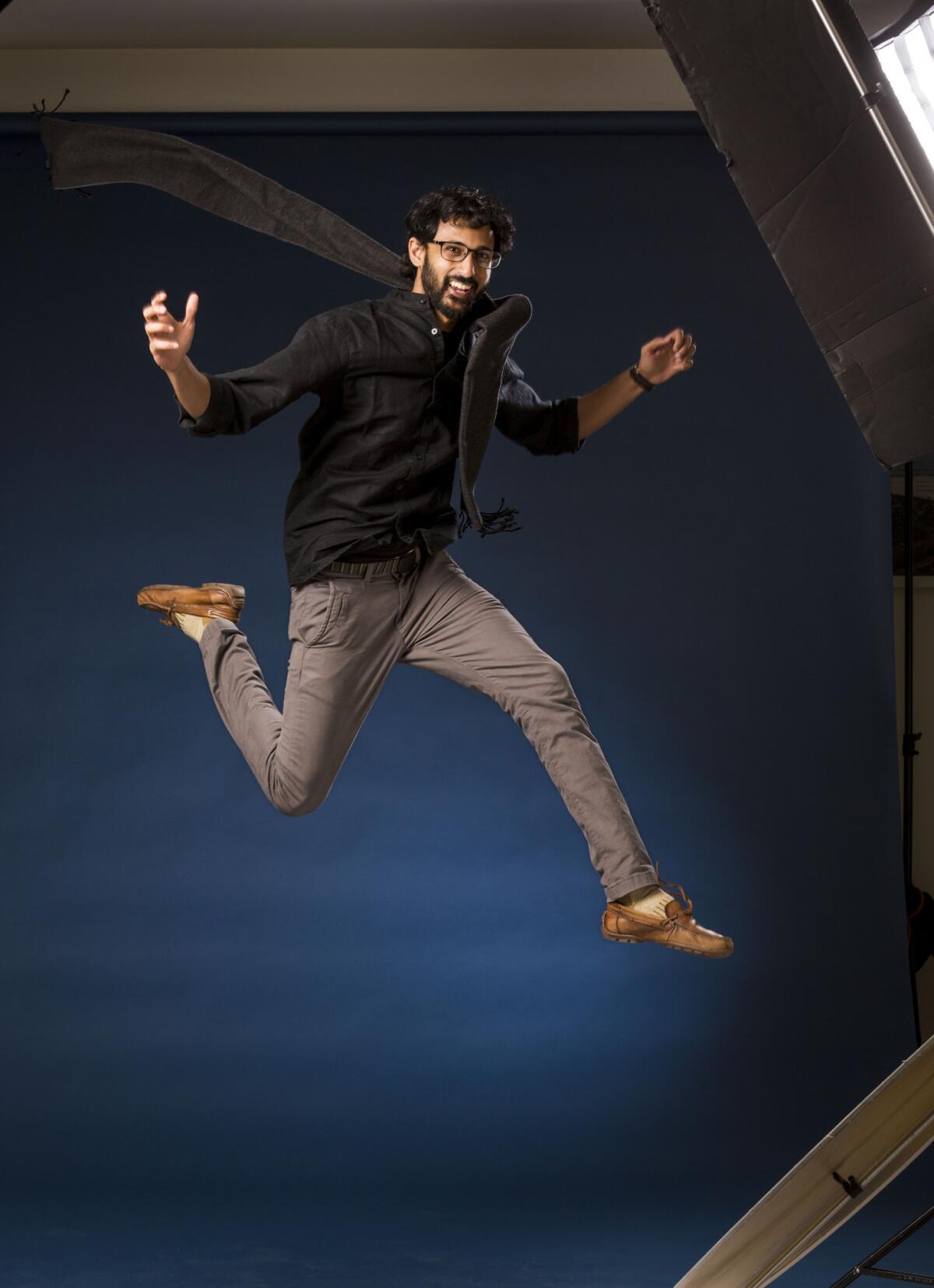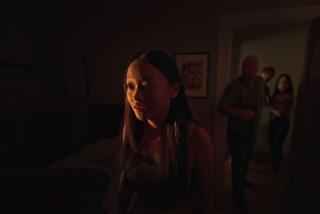Q&A: How Raam Reddy’s charming, feisty debut ‘Thithi’ uses digital filmmaking to establish realism

India’s Raam Reddy, director of “Thithi,” is shown at the Palm Springs International Film Festival.
- Share via
Reporting From Palm Springs — It all begins with a trash-talking great-grandfather: Century Gowda, a saucy 101-year-old who likes to occupy his mornings by giving his fellow villagers sharp-tongued, if charming, verbal beatdowns.
“Has your wife left you yet?” he asks a neighbor who crosses his path. “She found someone better?”
“Thithi” is not your average life-in-a-small-village picture. Plot-wise, this indie Indian film (shot in the Kannada language) is in keeping with the genre: successive and often conflicting generations of fathers and sons are forced to come together in the wake of the death of a loved one. In between, there are subplots about a ploy for land, a budding love affair and a number of missing sheep.
But “Thithi’s” strong performances (all by non-professional actors), tight pacing and pithy dialog make it more than the sum of its parts. Most impressively, it is the work of a first-time 26-year-old director: Raam Reddy, a polymath who counts fiction and photography among his other artistic interests.
The film picked up two awards at the Locarno International Film Festival in Switzerland over the summer (the first Indian film to be selected in eight years) and a top honor at the Mumbai Film Festival in the fall.
The director was in attendance at the Palm Springs International Film Festival earlier this month, where the film received a special jury mention in the “New Voices / New Visions” category. In March, “Thithi” will be one of eight films screened as part of New York’s New Directors / New Films series, which is organized by the Film Society of Lincoln Center and the Museum of Modern Art.
In this lightly edited conversation, Reddy discusses how he found his charismatic lead actors, how digital filmmaking techniques enhanced the film’s realism, why he chose death as a plot device and how a haircut halted filming for three weeks.
You capture the lives of three generations of men in ways that are both comedic and dark — with a lot of trash-talking banter.
That’s very culturally authentic. That is the way people talk. But the film has a very unique breed of humor that came out of the location itself. It’s not very typical at all. The personality of the film built itself in many ways. The humor and the writing is all very integrated with the actual culture of the actors and the voice of myself and my co-writer, Eregowda.

I understand that some of the characters were cast before you even finished the script.
We didn’t have a traditional casting. We just talked to people over months. For me, it was, “Do I say something as an artist?” Or: “Do I observe and just try to be a sieve that helps shape something that is already there?”
We had cast the three main characters [before the script was complete]. The film would live or die based on their performances. Getting them right on paper would be good. But it would be just as important to get them right on screen. We knew they were interesting people. But translating that onto the screen was key to the success of the film. So it was important for us to write knowing what they’d be able to execute.
At one point we wondered if we’d bitten off more than we could chew. These roles were very technical, they required a lot of acting.
So, for me, it was important for me to make them understand their motivations. They didn’t really get what we were doing. Cinema, to them, is not what we were doing. Cinema to them is [Bollywood]. A good movie is a movie that has more songs. A movie with eight songs is a better than a movie with five songs.
In the case [of the cast of ‘Thithi’], the father is really chasing some land, for example. He knows what that is like. So, he doesn’t have to think about how that would feel.
How frequently are films cast in this way in India?
It’s getting more common now. I think digital has changed that. If we were dealing with film stock, it’d be impossible. We’d have to have some real actors. But the ability to roll the camera without worrying about waste, that changes everything. So it’s becoming far more common. But the degree of complexity that we did, the treatment of realism, I haven’t seen too many other efforts in India that have attempted that in the way that we did.
In most films, it’s generally a mix between professionals and non-professionals. But we had all non-professionals. It was crazy. I could write a book about everything that happened. One of the leads cut his hair in the middle of the movie without telling us. We had to suspend filming for three weeks while his hair grew. [Laughs.]
But one of the main reasons I decided to be filmmaker was because I wanted to work with non-professionals -- to embrace realism as a style. To show the true side of India, the under-explored India. That, to me, is truly cinematic.
Where exactly does the film take place?
It takes place in a small village off the Bangalore/Mysore Highway in the Mandya District. It’s about two and a half hours from Bangalore, an interior village off the highway. India is so culturally dense, if you drive two hours, the culture starts changing. So this film is very culturally specific to that area. Eregowda, he’s from there. He knew some people and we found some people for the film. We specifically wanted to make a film in that village.
The story begins with a death -- and how various members of a family deal with it.
We wanted to make a film with life, with activity, that is kind of warm. If you walk in a village on a random day, life is very quiet. Everyone is out farming. The villages are empty, nothing is going on.
There are only three times in village life where things become frenzied in their activity: one is festivals, one is weddings and the third is deaths. This is the time when people come together. I felt like festivals were too culturally specific. I felt that weddings, well, it’s been overdone in film. So by process of elimination, we based ours on a death. It was a device on which we could build a story that is actually about life.
What kinds of films have served as inspiration in your work?
I grew up watching a lot of world cinema, not just India and not just Hollywood. It’s very hard for me to cite particular influences. It was quite scattered. But one of the things that gave me an interest in the overall realism and structure of a film was the American TV show “The Wire.” The way it’s this floating point of view with multiple characters and storylines. I studied their cut-points to learn how to cut small scenes into a realistic flow of life. There was a lot in “The Wire” that was important in [“Thithi”].
There were also certain elements from Eastern Europe, films that deal comedically with smaller towns and the lives of [the Roma]. Other films, too. I think of “The Band’s Visit,” about a police band getting lost in [Israel]. It deals with humor as a visual medium. And it deals with composition as a tool of humor.
There’s a little bit of Coen Brothers in the playful narrative movements and a little bit of Wes Anderson in the color treatment -- in using flat frames for humor, trying to suck the depth out of the shot. India has a lot of depth. We wanted to dry that out.
Are there any other projects you have your eye on?
I finished a final cut just three weeks ago. We are working on a distributor now. But I have a lot of ideas. Whatever I do, it will probably be very different from “Thithi.” I did a short film in Czech. I can wrap myself in any wrapper.
Find me on Twitter @cmonstah.
More to Read
The biggest entertainment stories
Get our big stories about Hollywood, film, television, music, arts, culture and more right in your inbox as soon as they publish.
You may occasionally receive promotional content from the Los Angeles Times.











